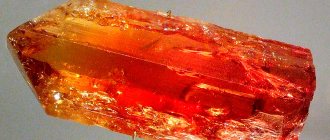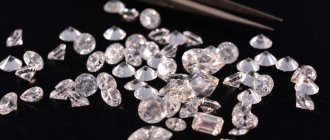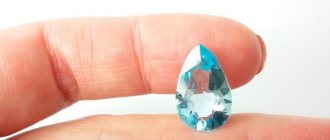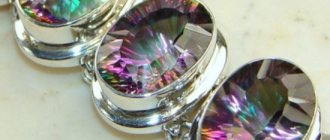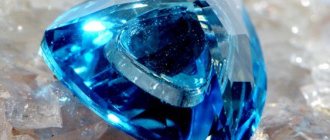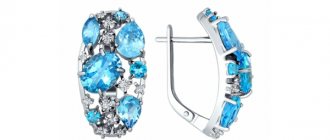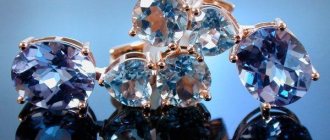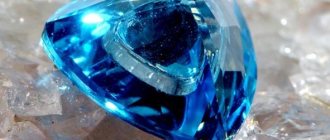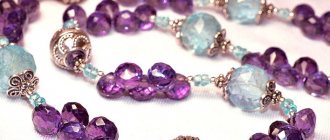BIG DIFFERENCE: PROCESSED OR ARTIFICIAL
Processed stones stand apart from real and fake gems.
It is difficult to call processed minerals “artificial”: they are almost identical to real ones.
| PROCESSED |
|
| ARTIFICIAL |
|
Durability.
Cubic zirconia is relatively hard and scores 8.5 on the Mohs Hardness Scale.
But in terms of durability, it is far from a diamond (diamond is rated 10 on the Mohs Hardness Scale). This means that cubic zirconia is easier to damage than diamond.
White topaz is close to cubic zirconia in terms of hardness (8 on the Mohs Hardness Scale), but it is softer.
In principle, none of these stones are comparable in strength to a real diamond. However, unlike cubic zirconia, white topaz is easier to scratch or break, and its color is more strongly affected by high temperatures.
In general, if durability is important to you in a stone, the best choice is cubic zirconia; it will serve you much longer and its edges will not wear off as quickly as happens with white topaz.
VARIETY OF TOPAZES AND FINISHES
Blue
The blue shade is the most recognizable: most people associate topaz with it. Shades range from pale to deep blue, or “London”.
Synthetic topaz is usually also blue. Rare natural cornflower blue minerals are mined in Brazil.
We recommend: Determining a REAL DIAMOND
Champagne
Truly regal and luxurious - a champagne-colored mineral. Such stones are often counterfeited - after all, the shade is rarely found in nature and costs hundreds of dollars.
Imperial
Imperial are called yellow, orange or red topazes. Despite their beauty, these stones are not in demand.
The rarest imperials are pink minerals. By the way, a natural stone is unmistakably distinguished by its pink hue: like colorless topaz, such topaz cannot be faked.
Rauchtopaz
“Smoky” (translated from German) topaz is nothing more than a type of quartz. Sellers may “forget” to explain this difference. The gem is a beautiful and deep brown shade, but should be sold as quartz.
Signs of a natural mineral
True blue topaz is characterized by a number of characteristics:
- A genuine stone will be smooth to the touch; processed crystals will have a smooth and silky surface, which is not the case with ordinary glass.
- If you rub the mineral on wool, it will become highly electrified and will attract dust particles, threads, and pieces of paper.
- An assessment of the crystal structure will help determine the authenticity of topaz. It should show inclusions and irregularities. Ideally transparent stones with an even, rich color are also found in nature, but are extremely rare, so they are expensive. It is better to refuse to buy such an impeccable copy at an average price.
- The natural mineral has a low shine.
- Natural stone is a poor conductor of heat, so it heats up slowly and its surface is cool.
- If you run a real gemstone over crystal, glass or quartz, the stone will leave a scratch on it. This experiment must be carried out carefully so as not to damage the product.
- Changes color slightly depending on lighting.
These tips are designed to help you determine the authenticity yourself at home, but only a jeweler will surely know how to distinguish a natural gem from a fake.
When purchasing, do not neglect the advice of a specialist. An obvious sign of a fake is a low price.
Sometimes blue crystals themselves can be an imitation of more expensive stones. They are sold as sapphires and aquamarines. In the first case, hardness is assessed (for topaz it is less than for sapphire), the refractive index of light and specific gravity. You can distinguish a stone from aquamarine by its stronger shine and play of colors. In addition, aquamarine has a silvery sheen that topaz does not have.
What criteria are used to determine the authenticity of a stone?
First of all, you should pay attention to the richness of the color of the mineral. In nature, topazes are found in amber, pink, blue, and occasionally reddish shades, but all these colors are soft and never bright.
Unlike glass and quartz, which have a rough surface and greater transparency, a true polished mineral is smoother and slipperier, less transparent and shiny.
The stone should also be checked for hardness: if it is real, it will easily scratch glass, crystal or quartz.
A few simple ways to check right at the counter
- When going to a jewelry store with the intention of purchasing a precious item, you need to grab a small piece of natural wool fabric and rub the stone with it. If it really is topaz, then it will immediately become electrified and will be able to attract a piece of paper to itself. Imitating minerals do not have such properties.
- Having chosen the decoration you like, you need to hold it in your hand for 1-2 minutes. Natural stone will keep you cool, while fake stone will heat up quickly. This effect is associated with the inherent low thermal conductivity of topaz, unlike, for example, quartz.
- Natural topaz is characterized by pleochroism - a change in color when the direction of the light flux changes. This phenomenon is especially pronounced in specimens with a yellowish and pinkish tint.
- When exposed to ultraviolet rays, genuine stones exhibit luminescence:
- natural pinks glow orange;
- blue - yellow or greenish.
If you have doubts about the authenticity of a mineral, you should weigh it on professional scales, which must be present in a jewelry store, and calculate at least approximately the density of the material. For natural stone it ranges from 3.5-3.6 g/cm3, and quartz, which is most often used to imitate topaz, has values almost half as low, about 2.6 g/cm3.
Absolutely reliable method
To obtain one hundred percent confidence that the stone is natural, simple available methods are not enough. This requires more in-depth research, which can only be carried out in laboratory conditions.
It is especially important to seek the help of professionals when purchasing rare and quite expensive stones of green, red or dark cherry color.
To carry out the examination, a pebble is immersed in a solution of methylene iodide and its behavior is observed:
- natural topaz will end up at the bottom;
- the artificial mineral will remain on the surface.
Some useful tips
If you love topazes, are interested in the method of processing them and how they look in the natural environment, you will not have any difficulty in figuring out how to distinguish topaz from a fake in the easiest cases - using visual inspection, electrifying the stone and paying attention to the brightness of its color and weight. You should also keep in mind that stones come in different colors both in nature and after processing. As already mentioned, their natural coloring looks much more modest than man-made ones. But both of them tend to fade over time. Especially if you do not take care of the jewelry and expose it to constant exposure to sun and light.
If you purchase an irradiated stone, keep in mind that it will unfortunately lose its brightness after a couple of years, even if cared for and stored in the dark. Treated stones do not have the ability to self-restore color, while natural topaz can "regenerate" if placed in a dark place. However, if you wish, you can take the faded mineral to a jewelry workshop and, depending on its condition, try to irradiate it again.
As for the cost, natural minerals of a more modest color are always more expensive than bright ones that have been processed. And this is understandable: such beauty often turns out to be short-lived. On the one hand, it is good if it can be restored for some time by subjecting the stone to repeated experiments. But on the other hand, it is impossible to maintain artificial brightness constantly, because regular irradiation and tinting will very soon negatively affect the appearance and structure of topaz.
The concept of “artificial topaz” has nothing to do with plastic, synthetics, or processed stones. Man-made stone, made by man, is not found on sale very often, and this concept should be distinguished from the word “fake,” which can easily include glass, quartz and even “tricky” cubic zirconia. Both synthetic and processed stone can safely be called natural. If you have some simple skills, this will allow you to distinguish real topaz from cheap glass or cheaper quartz.
Properties
Among refined blue topaz, three varieties are known today:
- Sky Blue is a soft blue topaz.
- Swiss Blue - bright blue or gray-blue.
- London Blue is a rich blue, the most beautiful and expensive of blue topaz.
physical characteristics
A fragile transparent or translucent stone with a glassy luster.
Other options:
- hardness on the Mohs scale - 8;
- density - 3.4-3.64;
- conchoidal fracture;
- perfect cleavage;
- rhombic system, crystallizes into short and long prisms.
Magic properties
Blue topaz is called the stone of composure. It will make the owner calm and reasonable, and protect him from outbursts of anger. Women wear jewelry made of blue and light blue stones, believing that it will preserve their beauty and youth longer.
The blue mineral has the reputation of being a treacherous stone. But that’s what it’s called by people who have something to hide, or those who are not ready to face the truth. And topaz is an uncompromising and honest stone, it is capable of exposing any lies and revealing conspiracies that are still being prepared.
The stone is even considered a destroyer of the family, since in its presence relationships that are not based on mutual love will not last long. Therefore, women, before wearing blue mineral jewelry, should think about whether they really want to know the truth.
But at the same time, the stone will always suggest the right decision, help predict the thoughts and actions of business partners, and indicate the path along which to move.
Blue topaz as a talisman
In earlier times, blue topaz was considered the stone of sailors and travelers. He led the owner on the right path, could save him from a raging storm and even pacify it. The talisman always returned its owner home safe and sound. In the modern world, these properties of stone are no less relevant.
The blue gem is credited with the ability to protect the owner from intrigue and disease. The blue stone makes people perceptive, not allowing them to miss the signs sent by fate. Topaz also helps to achieve success in life, financial and career. It gives its owner power over people.
Natural topaz: characteristics and places of extraction
In Russia, similar perlites are mined in the mountains of the Urals.
There, these stones were once called “heavyweights” because of their mass. More often they are found there small, completely colorless, transparent or pale bluish. Brazil is the leader in the extraction of natural crystals, where you can still find gems of different colors. There is even a black one, which is a very rare species. To this day, you can also find red specimens, no less rare in our time. They are now called Brazilian rubies. Topaz is also mined in the mines of Ukraine and Sri Lanka.
Modern technological processes make it possible to process natural gems and even grow them artificially in laboratory conditions. Such minerals also became known as nanostones.
Signs of a natural mineral
The crystal is very beautiful. For this reason, it is often confused with precious minerals. This is a semi-precious stone, but its properties, many of its types and shades of color are not inferior to expensive diamonds. The rarest specimens of this stone are also not cheap.
They contain iron with chromium and vanadium as impurities. Topazes come in different shapes: prismatic, short-columnar.
Natural topazes are hard. They leave scratches if you run them across the glass or crystal surface. But, being hard, these perrolites are also fragile when processed, and therefore require caution during cutting.
In bright light, these gems fade, becoming transparent with the shine of simple glass.
On a fracture, natural topazes are conchoidal. They do not dissolve in acids and are resistant to mechanical stress.
It is these properties that confirm the authenticity of the stones.
People certainly don't mind buying jewelry with synthetic stones, but they should know what they are buying. An important condition for purchasing fake crystals should be an appropriate price. After all, many people buy natural stones for medicinal purposes.
Artificial colors of natural topazes
Such crystals come in a wide variety of colors, and are even colorless. The most common ones found in mining areas are brown, yellow, blue, and pink. Crystals with different colors on the same stone have even been discovered. But usually among them there are nuggets with a combination of blue and dark yellow colors. Moreover, the color of the gem does not depend on whether there are impurities inside it. Different colors of the same stone arise due to structural defects. For example, blue shades appear when there is a lack of oxygen atoms, and yellow shades appear when there is a lack of fluorine atoms.
When the crystal is heated, the color gradually disappears, and under radioactive irradiation it intensifies.
The most common are colorless, several shades of brown, pink-yellow, as well as violet, reddish colors, golden yellow, blue and pure pink. It should be noted that natural minerals do not have such bright shades as artificial ones. Sometimes you come across natural gems with alternating colors and even with a “cat’s eye”. The most popular among them are: yellow wine, bluish, tea-colored and violet.
What is the difference
Nanotopaz is an artificial material that has the same chemical composition as natural material. Synthetic topaz is created in the laboratory. These are the most popular types of gems in the jewelry industry. They are used for inserts into various silver jewelry: pendants with bracelets, earrings with rings, brooches with necklaces.
How to recognize a synthetic stone
Of course, jewelry lovers here too have the right to ask a reasonable question about how to distinguish real topaz from synthetic one. What if you have to deal with such an instance? Since the technology for producing topaz crystal has been brought to perfection by specialists, even experienced jewelers cannot always tell by its appearance whether it is a natural stone or one grown artificially.
It is possible to check it in detail and recognize man-made topaz only by conducting an examination using special equipment. Crystals of natural analogues always have small flaws and imperfections that are not visible to the naked eye. When tested, synthetic topazes look too ideal - which suggests that they were created by man and not by nature.
These stones can be called unique - for the simple reason that they cannot be acquired so easily. Moreover, they have no visible difference with natural topazes. They are also subject to electrification and can fade in the sun; they have the same hardness and shine. Therefore, it is unfair to call them fake, especially considering that natural stones can be found much more often than man-made ones.
Unfortunately, people have not yet invented a less expensive technology for their manufacture. Therefore, artificial topazes can only be found at exhibitions, in museums or as exhibits in large gemological laboratories.
A few words about modern technologies and frauds
Technological progress is constantly evolving. Today, experts actually master a technique that allows them to artificially grow topazes, which, at first glance, do not differ at all from the real ones. Below we will talk in more detail about what such a synthesis is. But I would like to immediately note that this labor-intensive laboratory process is worthy of respect, in contrast to real fakes, when ordinary bright glass, the cost of which is pennies, is disguised as topaz. Skilled scammers, unfortunately, often counterfeit glass with topaz and skillfully sell it to unlucky buyers.
There is also a more “noble” method of counterfeiting topaz, when the initial raw material for their production is quartz, which is much cheaper. It is a mineral closely related to natural topaz in structure and appearance.
This product is well worth purchasing. But it is important that sellers do not deceive buyers and honestly say that this is an imitation of natural topaz, without inflating the price exorbitantly. Of course, you can meet honest and competent sellers in the jewelry business, but, nevertheless, in this environment no one is immune from deception.
Where are fake topazes used and how to care for them?
Jewelers are happy to buy nanotopazes to create beautiful jewelry. Similar analogues of jewelry can be inlaid with:
- earrings;
- rings;
- bracelets.
They create entire sets with such substitutes and they look very decent. Synthetic topaz is framed in gold and silver, platinum, and even products with titanium. The presented stones are in harmony with other gems, which is what jewelers take advantage of, creating stylish compositions at an affordable price.
To preserve the original appearance of synthetic stone, you should remember a couple of recommendations:
- The stone must be systematically wiped with a damp cloth, and then remove any remaining moisture with a dry cloth.
- Nanotopaz should not be subjected to mechanical stress or contact with household chemicals or cosmetics.
- It is better to store synthetic stone in a separate box, covered inside with soft fabric.
With proper care, such a stone will last for many years, and, looking at its perfect appearance, no one will guess that a high-quality fake is used in the jewelry.
Team LyubiKamni
Design options for products with natural minerals
To make jewelry with topaz look more impressive and acquire a chic iridescent shine, jewelry craftsmen additionally decorate the stones with rhinestones or colored glass. This design is completely acceptable and does not indicate falsification.
A very thin film is applied to pale blue stones by spraying, which gives the mineral iridescent tints. Over time, such a stone may fade, but it is not a fake.
Using simple methods for checking topaz for authenticity will help you avoid mistakes when buying jewelry and purchase a truly high-quality product with a semi-precious stone. Well, if you come across a rare stone, a more saturated color than usual, and it is not cheap, then it is better to turn to the services of specialists in order to have complete confidence that the product is real and not a fake.


